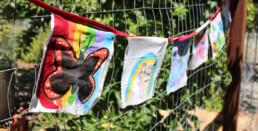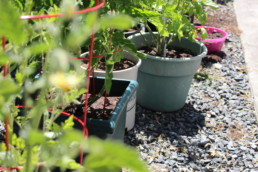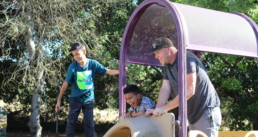Chuck's Virtual Coffee - March 2020
As COTS’ CEO, each month I take a moment to consider what I want our community to know about our organization and our progress in serving Sonoma County’s homeless. I look forward to sharing these thoughts with you in this Virtual Cup of Coffee – my monthly communique about the business and mission moments of COTS (Committee On The Shelterless). In the Business portion, I will share the nuts and bolts of what we do to serve the homeless – our successes and our challenges. In the Mission Moment, I will share stories about our clients and our wonderful staff who make it all happen.
This month’s newsletter is arriving earlier than usual, given the uncertainty we face today and my belief in the need to communicate our action steps around COVID-19 with our COTS family. Together, I know that we can meet the challenge of this moment and keep each other safe in the weeks and months to come.
All my best,
Chuck

Virus Prevention Plan – Vigilance While Caring for Each Other
People experiencing homelessness already have compromised physical, mental, and emotional systems. Living on the streets or in encampments with poor hygiene and dietary habits only makes matters worse. For those coming into a shelter environment and living in a congregate environment with 100 other shelter residents, practicing “social distancing” is difficult. And because our staff work with our clients every day, we are taking the threat of a rapidly spreading virus very seriously and with an overabundance of caution.
Three weeks ago, we issued Virus Prevention Protocols for all staff, shelter residents, guests, and volunteers of COTS. We received input from the Centers for Disease Control and Prevention (CDC), The National Alliance to End Homelessness, The Petaluma Health Center, and Sonoma County Department of Health Services.
We are cleaning and wiping down shelter countertops, doors, sinks, and shower handles, and mopping floors with disinfectant multiple times a day. We installed a portable hand washing station outside the dining room and posted flyers throughout the shelter and bathrooms about washing your hands. We implemented new questions for new clients to the shelter such as if they’ve experienced shortness of breath, coughing, or fever within the last two weeks. Thankfully, we have a strong partnership with the Petaluma Health Center where we will refer those clients. We also ordered and installed more hand sanitizer dispensers, wipes, and other disinfectant supplies.
Staff are also wiping down high touch areas like keyboards, phones, desk surfaces, and chair handles. We will continue to refine our protocols as the situation changes.
In good times and in bad, our community relies on nonprofits to serve the most vulnerable. Our goal at COTS will remain the same – to get people off the streets and out of our shelter and into housing to realize stable, productive, and fulfilled lives. We’ve been through two fires before and we will get through this by being calm, thoughtful, and hyper-vigilant about health and safety. As humans, we are at our best when we stay interconnected and love and care for each other.
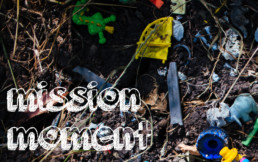
Ride-a-Long with Petaluma Police Department
Last week, COTS Outreach Specialist Jeff Schueller, Downtown Streets Team Director Karen Strolia, and myself accompanied Lt. Tim Lyons of the Petaluma Police Department (PPD) on his late night rounds of homeless encampments in Petaluma. It’s one thing to see the visible homeless walking the streets during the day but something totally different to see where they sleep at night and call home. Under highways, in thick brush, outside the entrance to businesses, empty homes, behind garbage containers, river banks, on top of buildings, and other very creative spaces…and often amongst much rubbish and filth. Lt. Lyons and one other police officer took three hours of their valuable time showing us over a dozen camps, and sadly, there were many more.
One person we met was from Alabama whose brother was a professional bass fisherman; another was living in a small wooden container and did odd jobs during the day for several businesses; another was living in the bushes with his dog and was a writer. Everyone we talked with did not want to come into a shelter. They preferred their freedom without rules. All had mental health challenges.
Lt. Lyons has been with PPD for thirty years and absolutely loves his job – and it shows. He was kind, caring, and very patient with everyone we met…and of course he knew their names. Some he had been working with for over twenty years. I asked Tim and Karen if they ever give up hope with the people on the streets, if some people just simply cannot be helped. And their response was an emphatic “never.” They firmly believe that everyone can be helped to lead stable and productive lives. Some just need special, more individualized services than others, but all can be helped.
As we moved from camp to camp, one thing became very clear – together with the Downtown Streets Team and Karen, PPD and truly caring people like Lt. Tim Lyons, Jeff Schueller, and our wonderful community, we can and will resolve homelessness in Petaluma.

Until next month,

Chuck Fernandez
Chuck's Virtual Coffee - February 2020
As COTS’ CEO, each month I take a moment to consider what I want our community to know about our organization and our progress in serving Sonoma County’s homeless. I look forward to sharing these thoughts with you in this Virtual Cup of Coffee – my monthly communique about the business and mission moments of COTS (Committee On The Shelterless). In the Business portion, I will share the nuts and bolts of what we do to serve the homeless – our successes and our challenges. In the Mission Moment, I will share stories about our clients and our wonderful staff who make it all happen. I hope you enjoy it, and I look forward to your feedback.
All my best,
Chuck

Funding Cuts by the County
You’ve probably read that the County of Sonoma will reduce funding to homeless service providers by 34% beginning July 1, 2020. They just don’t have as much funding to distribute as they did the previous year. They also mentioned that funding for the following year, 21-22, will likely be reduced. It’s too early to tell what impact Governor Newsom’s homeless funding proposal will have on Sonoma County. For now, the reduction is unfortunate and it’s also a reality of nonprofit life.
Over the past 14+ months, we’ve made many staff changes and department restructures to be as cost efficient and program effective as possible. We looked for opportunities to improve coordination, cooperation, and outcomes. Those changes put us in a position to better weather these types of cuts. Each person is responsible and accountable for their job, the expectations and outcomes as outlined in their job description, and to each other and their clients. We cannot carry anyone who is not. We also intentionally strengthened and invested in our revenue generating departments of Grants and Development to create stability and sustainability. Good stewardship means spending more time, not less, on grants, fundraising, and other administrative responsibilities like compliance and quality improvement, data, metrics, and outcomes.
COTS is blessed as private funding continues to be strong and our community continues to believe in and support our Mission and Vision. We are grateful for you. Thank you.
How do nonprofits survive and thrive in an ever-changing funding environment that allows them to achieve their Mission, not change who they are just to qualify for a grant, and perhaps not be a traditional charitable organization?
I’m often asked why nonprofits don’t merge with each other. If there are 10,000 nonprofit organizations each serving 100 clients, should there instead be 100 nonprofit organizations each serving 10,000 clients more cost efficiently and with improved impact?
As we move forward, we will consider all of this and more to ensure that we are responsible stewards of your cherished investment in COTS and that we continue to help people transition from homelessness to a permanent home.

Clockwise from upper left: Development Manager Eileen Morris, Shelter Services Manager Robin Phoenix, Chef Janin Harmon, and Facilities Manager John McEntee
Roundtable by Congressman Jared Huffman
On Monday, Congressman Jared Huffman was at COTS conducting a Roundtable. We were delighted to host the Congressman and about 22 community leaders from Sonoma County. The Congressman wanted to know how he, on a federal level, can support effective homeless and housing strategies in our County through funding, policy, and advocacy. He was looking for solutions.
There were lots of suggestions and concerns raised. The need for sustainable funding instead of just for one or two years; the noticeable rise in hate speech and violence towards those experiencing homelessness; the need to push people out of their comfort zones and to force the conversation to solutions; that homelessness has negative impacts on the environment; that there needs to be a more coordinated and organized continuum of services and not organizations and services working in silos; that we need much more funding to solve challenges with mental health and substance abuse and addiction. The Congressman is having these Roundtables throughout his District to better inform him of the challenges we are facing and some possible solutions.
Hosting your Congressman is no easy feat. At the same time as the Roundtable was going on, we had a training ten feet away to prepare for our Annual Point in Time Count being done on Friday. This is where hundreds of people go to all parts of Sonoma County at 5am to count those experiencing homelessness. On top of that, we have to care for and feed over 112 homeless residents for breakfast and lunch. Our staff and shelter residents did a beautiful job with the logistics of parking, cleaning the shelter to be presentable, ensuring residents are fed, hosting two simultaneous events, and appearing calm and controlled during it all.
So much thanks goes to our staff and shelter residents for a smooth-running morning. Special thanks goes to Development Manager Eileen Morris, Shelter Services Manager Robin Phoenix, Facilities Manager John McEntee, and our chef Janin Harmon for taking charge and working with their teams on the many details behind the scenes. Many of us were excited to host this event and there was a real sense of pride in showing off the Mary Isaak Center.
Another busy and satisfying day at COTS.

Until next month,

Chuck Fernandez
COTS Day Use Services for Evacuees
Dear COTS Community,
Please spread the word: Evacuees are welcome to use the Mary Isaak Center, 900 Hopper Street, Petaluma for showers, laundry, meals and phone charging. All services are free.
Showers and laundry services are available between 9 a.m. and 5 p.m. Please note that our washing machines are few, so you may have a wait.
COTS is now also serving three meals a day to anyone who is hungry. Meal hours are below:
Breakfast: 7:30 to 9 a.m.
Lunch: 11:30 a.m. to 1 p.m.
Dinner: 5 and 6 p.m.
Volunteers Needed!
If you’re a regular COTS volunteer, we could use your help coordinating laundry and showers. Please get in touch with the front desk: 707-765-6530 x120.
We would be very grateful for the following donated items to help us serve the community:
• Towels and wash cloths
• Shampoo, body wash
• Bedding/sleeping bags
• Laundry detergent
• Toilet paper
• N95 masks
Thank you to everyone in our community who is pitching in to help those who have been evacuated due to the fires. Thanks especially to our first responders who are keeping us safe. Together, we are proud to be Sonoma Strong!
Chuck's Virtual Coffee - September 2019
As COTS’ CEO, each month I take a moment to consider what I want our community to know about our organization and our progress in serving Sonoma County’s homeless. I look forward to sharing these thoughts with you in this Virtual Cup of Coffee – my monthly communique about the business and mission moments of COTS (Committee On The Shelterless). In the Business portion, I will share the nuts and bolts of what we do to serve the homeless – our successes and our challenges. In the Mission Moment, I will share stories about our clients and our wonderful staff who make it all happen. I hope you enjoy it, and I look forward to your feedback.
All my best,
Chuck

Housing First is Not Housing Only
The Housing First (HF) approach is based on three core principles. One is that homelessness is primarily a housing problem and housing is the foundation for life improvement. Once basic necessities are met like shelter, food, warmth, and security, and the person is no longer in crisis wondering where they are going to eat or sleep, then they can concentrate and get the help they need. The second principle is the importance of removing barriers to get housing such as addiction, lack of income, or a criminal background. These issues are best addressed once housed.
The third principle, and what I believe to be the most critical to successful HF, is intense case management or wrap-around services to address their many needs. This is what will determine if a person will remain stably and successfully housed. Why is this so important?
After years of living on the streets, learning to live in an apartment is not as simple as unlocking the door and walking in. Housing comes with rules – no smoking, paying rent on time, cleaning your place, and simple things like taking your keys when you leave. Formerly homeless individuals are now living by someone else’s rules – the landlord’s. Living on the streets is different – you have no keys, you live hour by hour, there are no bills to pay. Leaving the streets means abandoning the past and imagining a new future. It means learning how to shop, making a budget, and planning ahead. Loneliness can also set in because friends are still on the streets or in shelters. That guilt can trigger old behaviors. All of this can be more challenging than living on the streets.
Given the economics of Sonoma County and the lack of affordable housing, just finding a place to live is difficult, so once you get a place, you need to do everything possible to keep it. This is where intense case management comes in – to help recondition people’s behaviors, help people become accountable and responsible for apartment living, and think differently. Someone said that a formerly homeless person could fall in and out of housing two or three times before they finally get it right. With intense case management, hopefully we can get it right the first time.
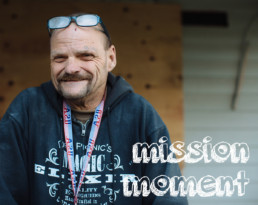
Don’t Judge a Book by its Cover
Have your parents ever said, “don’t judge a book by its cover?” Mine did – meaning don’t judge a person’s value or humanity by an outward appearance.
I’ve known Jimmy, one of our clients at the Mary Isaak Center, for almost ten years. I first met him while working for another shelter organization in Santa Rosa. The shelter desperately needed lots of beautification on the inside – painting, changing lights, fixing bathrooms, and more. Of course we had little money to do the work. So I asked about volunteers and Jimmy jumped in to help. He had experience with “handyman” type work. Jimmy was an absolute delight to work with and be around – forever positive, high energy, always wanting to help, showing up on time and working until the job is done. When someone needed help, Jimmy was there.
I saw Jimmy last week at the Mary Isaak Center. I’ve not seen him for several years. Still on the streets, still struggling with addiction, but still positive, upbeat, and energetic. He said he feels safe at COTS. He wants help and said, “we all want help.” He said the food is good at COTS, in fact he’s gained nine pounds. He looks good and healthy. Jimmy is also bald, has a goatee, wears a tank top, and has lots of tattoos. He said people walk on the other side of the street when they see him because they’re afraid of the way he looks. That hurts Jimmy. He’s taking steps to get rid of his tattoos.
Like many of us, I’ve been guilty of judging people by their appearance. And when I took the time…when I “opened the book” and got to know their story, I saw I was wrong in how I pre-judged them. My parents also said, “it’s what’s on the inside that counts.” I got to know Jimmy and I’m glad I did – he has a heart of gold.

Until next month,

Chuck Fernandez
COTS September Newsletter: Going green and keeping kids safe

Sow success with the COTS Hour Seed Fund
Every year in November, we host The COTS Hour: a huge fundraiser where we gather with our community and share stories of hardship, resilience, and triumph. This year, The COTS Hour will be held at 8 a.m., November 14 at the Petaluma Veterans Memorial Hall. We’re expecting 450 people to attend and raise funds in support of our vital programs and services throughout the year.
We wish we could host all of Sonoma County at The COTS Hour, but we know many of you can’t join us because you’ll be out of town or clocking in to work. This year, you can help before the event by giving to The Seed Fund. Your support demonstrates our community’s investment in our neighbors experiencing homelessness – and encourages our guests to give generously on November 14!
Join us and help us continue this crucial work: click here to donate to The Seed Fund and launch your fundraising page today!
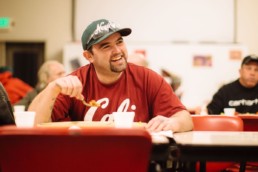
Saving the planet one free meal at a time
What does our work at Mary’s Table have to do with global environmental health? Quite a bit!
About 35 percent of all food in the United States never gets eaten—at a huge cost: a greater need for agricultural land; gallons of precious water wasted; and greenhouse gas emissions that went for nothing.
But thanks to all the food donations we use each year at Mary’s Table, 98 tons of perishable food go into people—not landfills. And those scraps that we don’t use go into animals or into compost. Many thanks to Recology for helping us develop a robust composting program.
We couldn’t feed our guests without the support of many, many food providers, including our local grocery stores and farmers.
And our volunteers are absolute climate heroes. They coax every delicious, usable bit out of our fruits and vegetables.
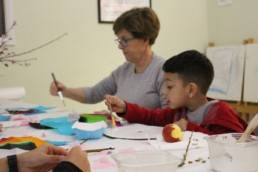
Healthy development happens when kids are safe
Here are a few good bits of news from our Kids First Family Shelter.
“Eddie” clings to his grandmother. She’s his anchor in the world. At school, he couldn’t sit down at his desk without his grandmother by his side, couldn’t make it through the rest of the day once she’d said her goodbyes. After moving into KFFS and finding the stability it provides, Eddie is starting to feel more confident. Two weeks ago, he walked into his classroom all by himself and stayed the entire day. We predict he’ll be able to ride the school bus on his own soon.
When “Valerie” arrived at the shelter, she was shy and wasn’t using speech the way other kids her age do. Today, although no one would call her a chatterbox, she’s begun to relax at the shelter, to come out of her shell, and to speak more. Your support helps give all our kids at KFFS the space to breathe and to feel safe again. Thank you for investing in Sonoma County’s next generation!

Housing lets us breathe
There are few words tenants dread more than, “We’re selling the house.” That’s because those words are usually followed by “And you’re going to have to move.”
Six tenants in COTS’ shared Integrity Housing program recently heard both phrases. Their landlords had rented to the Integrity Housing program for six years at a very affordable price, but they had reached the conclusion that they had to sell the home.
COTS had to deliver 60-day notices to move to all the formerly homeless tenants. We let them know that we’d try our best to find them new housing within the program, but that we couldn’t make guarantees.
The residents are in their 50s, 60s and 70s. Only one resident brings in income greater than $1,000 per month. All of them have severe and painful health challenges.
“I couldn’t breathe or focus when we got the notice,” one resident said. “I just kept thinking, ‘I am too old to be out on the streets again.’”
“I had no options,” said another. “I didn’t know what to do.”
A husband and wife who live together in the house were preparing for the possibility that they might need to split up—that there might be space and rent money enough for only one of them.
“We were working on housing plans,” said COTS Case Manager Debbie Robbins. “Those were some tough discussions.”
We were determined not to lose hope. COTS had received a grant from the Finley Foundation in 2018 to purchase a house, and we realized we now had an incredible opportunity: if we could buy the property before it went on the market, we could keep our clients housed and generate income to support COTS’ programs for the long-term.
With the help of the Finley Foundation, the generous sellers, and our amazing community, we closed on the house on August 30, 2019! We are so grateful to the following partners and businesses who made this happy ending possible:
-
- the Finley Foundation, which provided funding for the purchase.
- the sellers, Dennis and Terry Merrill, who worked with us in the same of spirit of ease. cooperation and generosity that characterized all their business dealings with us.
- Bonnie Merrill, a local realtor and past COTS volunteer, who connected us with Dennis and Terry in the first place – and helped bring them into the Integrity Housing program.
- Dan and Rene Foppe of DNR Pest Control, who donated the necessary pest inspection.
- Terry Lewis of North Coast Inspection, who donated his inspection services.
- Rebuilding Together Petaluma, which is going to help us with repairs and upgrades on the property. (Sign up to volunteer at rtpetaluma.com/volunteer!)
- and Bill Gabbert and Karl Bundesen of Century 21 Bundesen who negotiated the sale and donated all their fees.
With the addition of the house to our permanent Integrity Housing portfolio, we will be able to house clients in Petaluma long into the future. We could not have done it without so many generous community members pitching in to help us make it happen.
“I hope people will see this as a model for providing affordable housing,” said one resident.
Richard Stark, a COTS client and a long-time Petaluma resident whom people might remember from his days playing piano at Copperfield’s, says that he remembers many afternoons chatting with Mary Isaak in her backyard back in the early 1980s. “We were talking about a way forward for humanity,” he said, “about saving the world.”
Mary went on to co-found COTS with her friend Laure Reichek and the help of thousands of supporters.
“I didn’t know it then,” Richard said, “but she really did it. She saved people. And her work saved my life.”
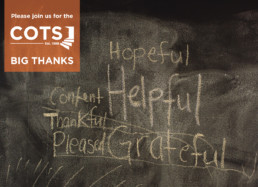
Please join us at The Big Thanks
We can never thank you enough for your support.
But we’d like to try!
Please join us at The Big Thanks at 7 p.m. on Tuesday, October 15 at the Petaluma Woman’s Club.
We’ll show you how we put your support into action—what your donations, your volunteer hours, your advocacy accomplish. And we’ll enjoy great music from Hannah Jern-Miller as well as good company, food and drink.
We are so grateful to you for your support. Thanks to you, COTS can now provide the supports to keep over 400 people in permanent housing annually and 140 people in shelter on any given night.
This is a free event. Please RSVP by clicking here!
Chuck's Virtual Coffee - August 2019
As COTS’ CEO, each month I take a moment to consider what I want our community to know about our organization and our progress in serving Sonoma County’s homeless. I look forward to sharing these thoughts with you in this Virtual Cup of Coffee – my monthly communique about the business and mission moments of COTS (Committee On The Shelterless). In the Business portion, I will share the nuts and bolts of what we do to serve the homeless – our successes and our challenges. In the Mission Moment, I will share stories about our clients and our wonderful staff who make it all happen. I hope you enjoy it, and I look forward to your feedback.
All my best,
Chuck

Homelessness is Expensive
Managing homelessness is costly – to the economy, environment, health care, criminal justice system, and our fellow human beings. Estimates range from $30,000 to $50,000 a year per person that is chronically homeless, defined as being homeless for at least one year or longer with serious disabling conditions such as mental illness, substance use disorder, or physical disability.
A six-year study of some 104,000 homeless individuals in Santa Clara County showed that the county spent $520 Million a year or $3.1B over the six-year period on homeless services. The highest utilizers accounted for 47% of all costs and averaged over $100,000 per year.
53% of the annual costs was for health care. Serious health issues cause and result from homelessness. Living on the streets makes it difficult to get regular medical care, to rest and recuperate, and only exacerbates any illnesses, thus increasing medical costs. Of the annual costs, 34% was for the Justice System as homeless individuals also spend more time in jail or prison due to violations such as loitering or sleeping in cars. Then there’s the environmental impact – trash, human waste, rubbish from encampments, and polluted waterways – and the cost of the required clean-up. There’s also the costs to businesses such as reduced foot traffic in business districts, lower real estate values, or increased maintenance costs.
Various funding sources pay for these services – grants from the federal, state, and local government, private foundations and businesses, and generous donations.
The solution that many counties have adopted is the Housing First model. The premise is that homelessness is primarily a housing problem and that housing is the foundation for life improvement. Once the basic necessities like food, water, and shelter are cared for, then people are not in crisis and can focus on critical elements like employment, mental health, physical health, and other challenges. Studies show that getting someone housed quickly with supportive services results in significant decreases in use of emergency rooms, hospitalizations, incarcerations, and shelter stays. Estimates of the annual cost of housing someone for one year ranges between $15,000 to $20,000 versus $30,000 to $50,000 and even the $100,000 costs for high utilizers.
In Sonoma County, there is a moral and economic imperative: we need more housing units. Given the costs to our community, no one should be living on the streets.
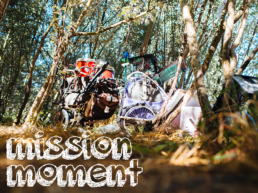
Life in Encampments
Last week, I visited several encampments with our street outreach specialist Cecily Kagy. It was an eye opener. One encampment was very clean – no rubbish, needles, empty alcohol bottles, or urine and feces. They had rules and everyone had responsibilities, much like a home. There was a set-up for a shower, a cooking area, and a daily routine where several people would go out during the day to search for food and water. There were even plastic flowers hanging from one of the tents to make it feel homey. It was clear talking with the residents that they want to be in a home, want a job, and want to feel part of society and not looked down upon. One person teared-up when talking about her kids and grandkids.
We went to another encampment that was not so clean. Lots of rubbish, car parts, and dilapidated motor homes completely filled with stuff. Hoarding can be a psychological effect of homelessness: there is this feeling that, “If I can just have this stuff, then I will feel better.” Many of those experiencing homelessness have also lost people and things in their lives, so hoarding items can be a reminder of a life they used to have or hope to have, thus the need to stock up and be prepared.
We talked with one person who preferred living by himself. His grocery cart contained everything he owned. After graduating from a prestigious university, he started having mental health challenges and then just drifted from city to city. He didn’t want to be confined in a home or a shelter with other people. He was bright, articulate, and engaging. Cecily was able to bring him into the shelter last month to shower – his first time bathing in three years.
Through all of these encounters, Cecily was never in a rush – talking, hugging, smiling, joking, and genuinely engaging with everyone. She was part counselor, motivator, disciplinarian, parent, friend, and fellow human being who related to everyone and earned their respect because she was once homeless and on the streets herself. She said clients will sense if you’re in a rush because it means you don’t care – and if you don’t care, then you lose their trust. If you lose their trust, there’s no chance of helping them access services that will get them into a home.
While I don’t have a magic wand for ending homelessness, one thing is for sure. We can all be part of a solution by first being just a little bit like Cecily – taking the time, reaching out, and lending a helping hand to a neighbor in need.

Until next month,

Chuck Fernandez
COTS August Newsletter: Backpacks, bounty, and Business in the Ballroom
Styled for school success
Many thanks to the Petaluma Valley Rotary and the Active 20-30 Club of Petaluma for getting our kids excited about going back to school. New backpacks, school supplies, shoes and clothes help kids feel like they fit in. That’s especially important for the kids in our programs who have often experienced a lot of upheaval and are starting out as “new kids.”
Petaluma Valley Rotary is supplying brand new backpacks stuffed full of supplies and the Active 20-30 Club is taking kids shopping for school clothes. Together, their efforts will mean a better start to the school year for all COTS’ kids and families!

Investing in our children
Sonoma County has invested heavily in Rapid Re-Housing—a program where short-term rental assistance is paired with services to help homeless families stabilize quickly, and soon, shoulder their household expenses independently.
There are good reasons for that investment. According to a 2015 study, five families can be stabilized through rapid re-housing for the same price it takes to house one family in a transitional housing program. We’re finding that study to ring true here in Sonoma County. On average, COTS will pay about $6,000 in rental support to our Rapid Re-Housing landlords as our clients get back on their feet. And over 90 percent of our clients remain housed once our assistance ends.
In our last fiscal year, which ended June 30, we housed more than 200 people through Rapid Re-Housing.In the month of July, 2019, we housed 45 additional people through Rapid Re-Housing.
Wise and efficient use of our limited resources is good for the entire community. And the beautiful thing is that it’s best for our families, too. Nothing is more disruptive for a child than a period of prolonged homelessness.Permanent housing correlates to better health, better academics and a more successful adulthood.
Thanks to all our supporters for investing in COTS’ life-changing programs and services.

Feeding a crowd and caring for the planet
Over half of the produce grown in the United States goes to waste, according to the Journal of Consumer Affairs of the National Resource Defense Council. Part of the waste comes down to aesthetics: we just won’t buy it if it’s not sleek and pretty.
But anyone who gardens knows that wonky fruits and vegetables taste just as good as their more elegant counterparts. And anyone who’s been to Mary’s Table knows that we are always on the look-out for fresh produce. We serve over 7000 meals a month, and we’ve pledged to fill each one of them with fresh fruits and vegetables.
Preserve Sonoma Farm Kitchens, The Center for Spiritual Living and Jacobs Farm Del Cabo just helped us with that pledge.
Merrilee Olson owns and operates Petaluma’s Preserve Sonoma Farm Kitchens and she’s dedicated her life to using the whole harvest. Merrilee secured a donation of 780 pounds of organic tomatoes from Jacob’s Farm Del Cabo in the Santa Cruz area. Then she enlisted the help of her fellow congregants at the Center for Spiritual Living in Santa Rosa to turn those tomatoes into 600 jars of marinara sauce for Mary’s Table.
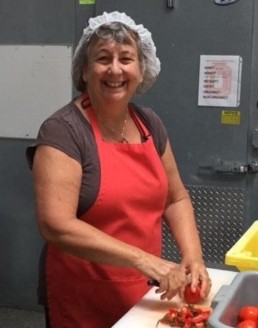
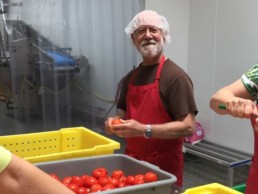
Last Saturday, the volunteers donned hair nets and close-toed shoes and persevered through heat, noise and technical difficulties to create beautiful jars of sauce that we’ll serve at Mary’s Table and give away to residents in our housing programs.
The Center for Spiritual Living chose COTS as a beneficiary of its 2019 charitable giving. Congregants were eager to do even more, Merrilee says. “I put out the word that I needed volunteers and people came.” Merrilee had eight volunteers from the Center helping her and one paid staff member.
Jacobs Farm del Cabo was one of California’s first certified-organic farms. “At Jacobs Farm del Cabo we recognize the unsustainability of food waste and are proud to donate fresh organic produce to community organizations like Mary’s Table,” says Marketing Coordinator Wylie Bird.
According to waterfootprint.org, it takes 26 gallons of water to produce a pound of tomatoes, so using these 700 pounds of tomatoes that would have gone to waste is ensuring thatover 18,000 gallons of water were used well.

Thank you to everyone involved in this heroic effort! When we take care of each other, we can also take care of the planet.
Reminder to all our supporters: Mary’s Table, 900 Hopper Street, is open to the public free of charge for lunch and dinner. Hours are 11:30 a.m. to 1 p.m. and 5 to 6 p.m. every day. Please help us get the word out to anyone who is struggling to make ends meet.
Business in the Ballroom and Picnic in the Parking Lot
Thank you to everyone who came to Business in the Ballroom on July 25 at the Hotel Petaluma. We were thrilled that so many people came out to recognize and commend our incredible business supporters!
Many thanks to the people and organizations who made the event possible: the Hotel Petaluma; the Petaluma Area Chamber of Commerce; Side Dish; Jackson Family Wines; Lagunitas Brewing Company; and Century 21 Bundesen. Thanks to Joy Regan for her lovely photos.

COTS co-founder Laure Reichek celebrating at the COTS Community Picnic
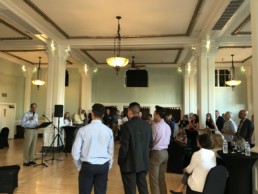
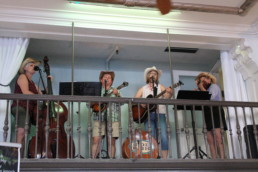
Thanks also to everyone who came to our COTS Community Picnic on July 11 to celebrate the expansion of our free meal program. Now, in addition to our regular lunch offering, our dinners are open to anyone in the community who is having trouble making ends meet. There’s no paperwork involved. Our stalwart volunteers serve lunch between 11:30 a.m. and 1 p.m. and dinner between 5 and 6 p.m.
Restaurants to the rescue!
Two of Petaluma’s finest restaurants have each taken over a meal slot at Mary’s Table. McNear’s restaurant is preparing and delivering Thursday evening dinners and Seared is delivering Monday lunches. These generous deliveries will supplement the meals prepared by our volunteers and staff on other days of the week and give our clients a taste of Petaluma’s best.
Together with his wife Carrie, owner Ken O’Donnell delivered and served the first meal on Thursday: baked chicken with a garlic glaze, pesto pasta and vegetables. What a treat! Thank you!


Client profile: Don
The urge to beautify our surroundings is universal. For Don, for many years, his design space was limited to his walking stick, a craggy piece of 100-year-old Eucalyptus. He pressed into the wood his mother’s birthstone, a ring from a happy period of his life, stones and talismans, each representing births and deaths and friendships.
Don’s childhood in Sonoma County was rough, he says. He joined the military and discovered a mechanical aptitude. He worked a variety of jobs but fell into homelessness when one personal tragedy followed another and another. He camped and couch-surfed and occasionally stayed in shelters. He prided himself on keeping a clean and tidy campground. That all changed when a driver making an illegal turn sent Don flying off his bike. He landed yards away with bruises, a concussion, and multiple broken ribs and limbs. The driver fled, never to be seen again.
Still convalescing, he entered our Permanent Supportive Housing program ten months ago. He shares a mobile home with another gentleman and works with case manager Kathleen Sinnott. She helps him get to his medical appointments and wade through the paperwork from his accident.
Don still has the walking stick, but, now, his mobile home is his canvas. Boxes and cans line the kitchen shelves in artistic displays; just-plumped pillows perch on the couch; animal figurines pose together on the television; in the garden, sun catchers surround his thriving tomato plants.
“I just like things nice,” he says.

Chuck's Virtual Coffee - July 2019
I would like to sit down and have a cup of coffee with you to share our progress in serving the homeless, and hear from you about what we could be doing differently or better. Until then, I’d like to introduce you to a Virtual Cup of Coffee. This is my monthly communique about the business and mission moments of COTS – Committee On The Shelterless. In the business portion, I will share the nuts and bolts of what we do to serve the homeless – our successes and our challenges. In the mission moment, I will share stories about our clients and our wonderful staff who make it all happen. I hope you enjoy it, and I look forward to your feedback.
All my best,
Chuck

Point in Time Count Results
In February, I talked about participating in the annual Homeless Point in Time Count. It measures the prevalence of homelessness in each community and collects information on individuals and families in emergency shelters, transitional housing, and people sleeping on the streets, in cars, abandoned properties, or places not meant for human habitation. The count is the only source of nationwide data on homelessness and is required by HUD (Housing and Urban Development) of all jurisdictions receiving federal funding for homeless services.
The results of the count were released in late June.
For all of Sonoma County, the total homeless population was 2,951, down by 45 people or 1.5% from 2,996 in 2018. For Petaluma, the count was 265 people – down 20 from 285 in 2018. Not big changes but we are moving in the right direction.
The biggest increase was with unaccompanied children and youth, which increased from 515 in 2018 to 666 in 2019 or 29%. Young people have a harder time accessing services due to the stigma of their housing situation, lack of knowledge of available resources, and fewer services available for youth.
Eighty-seven percent of the people surveyed reported living in Sonoma County prior to becoming homeless. Of that, 70% reported living in Sonoma County for 10 or more years. I am often asked whether most of the homeless are local or from out of state or county, but the survey shows that these are our neighbors, our coworkers, even our friends.
Nineteen percent of those surveyed reported that their previous housing or sleeping location was affected by the 2017 fires and of those, 37% reported that their home or sleeping location was burned or destroyed by the fires.
Homeless veterans increased slightly from 207 in 2018 to 210 in 2019. Veterans experience higher rates of PTSD and TBI (Traumatic Brain Injury), sexual assault, and substance abuse, and are more likely to live on the streets versus shelters.
The survey also showed that the primary causes of homelessness were job loss, argument with family or friend, alcohol/drug abuse, eviction, and divorce or separation. The biggest obstacle to finding housing was not being able to afford the high rents. The most common health issues were drug or alcohol abuse (38%), psychiatric or emotional conditions (35%), PTSD (25%), and physical disorder (25%). Thirty-four percent reported a history of domestic violence and 16% reported trading sex for money due to their vulnerable circumstances and precarious access to basic needs.
Another question I hear is, “Do the homeless want to be housed?” Eighty-nine percent of those surveyed said they would want a home if one were available and affordable.
So what does this all mean? We have our work ahead of us to successfully address this very complex social issue. While the focus must continue to get people housed, we cannot forget about the need for more mental health counseling, longer case management support, and simply walking side by side with dignity and love until those experiencing homelessness are ready to be independent.

Shelter Rules and Client Advocacy
I often get the question about the rules at the Mary Isaak Center. Yes, we have rules against behavior such as violence or threats of violence toward staff or residents or use of alcohol or drugs in the shelter. It’s one way to maintain a sense of order and safety for our clients.
But we must be careful in how we carry out rules. An environment emphasizing rule enforcement can produce anger, resistance, and even rebelliousness. “If our residents have no way to express their feelings or are afraid to raise concerns with staff, then they may take their anger out on other residents.” One resident recently said to me, “we are all damaged people and we just need help.” A punitive environment only exacerbates that sense of despair. Moreover, strict rule enforcement without understanding a resident’s history can also impact staff morale.
At COTS, we balance shelter rules with advocacy. Each resident has the right to be respected, to be heard, to self-determination, and to reside in a clean and safe environment. We know that often, clients cannot advocate for themselves as they may not have the experience, self-confidence or know-how. So our case managers advocate for them. We help them clarify their goals, give them information about resources and opportunities that are best for them, and help them pursue housing, employment, and treatment. If someone acts out, we try to find out what is really going on. Yes, we exit people from the shelter for gross violations of rules. But we also make every effort to give each resident a warning and a second chance. The case managers have weekly meetings about each resident and their progress toward their goals. Case Managers take seriously their responsibility to help each resident be successful. Their advocacy for each resident is aligned with our mission of helping people transition from homelessness to housing and our values of Accountability, Respect, Integrity, and Results.
Living in a shelter is difficult. We hope our practice of rules balanced with strong advocacy results in harmony with 100 people living in a common space. We are grateful to our residents for trying to keep the Common Good of their neighbors in mind while at the Mary Isaak Center.

Until next month,

Chuck Fernandez
COTS July Newsletter: 195 Moving Days!
Rapid Re-Housing Update
Now that COTS’ fiscal year has ended, we are thrilled to share this year’s Rapid Re-Housing numbers. Since July 1, 2018, 195 people, including 82 children, have found housing and support through our program.
What is Rapid Re-housing? It’s a relatively new approach to homeless services, a state and federal “best practice” informed by a body of research indicating that moving individuals experiencing homelessness into housing quickly – rather than having them endure long stays in a shelter – benefits the interests of both those individuals and the broader community. With a home, people are much better able to take care of their health, increase or stabilize their incomes, and stay clear of trouble. The benefits that a stable home brings to a child is even more pronounced: academic, social and emotional outcomes skyrocket once children are stably housed. The benefits to our clients translate to reduced healthcare and other public sector costs for the broader community. (Read more about our Housing First approach here.)
As part of our Rapid Re-Housing program COTS is able to provide time-limited financial assistance and supportive services to clients transitioning out of homelessness. The idea is to find housing that they’ll be able to afford once on their own once our support ends.
Supportive services help our clients achieve that self-sufficiency and can include help with a job search or with job skills-development, linkage to childcare, healthcare or other services. The services we provide are tailored to each family’s needs and desires.
We are grateful to the many funders who make this program possible: all our COTS supporters, the Redwood Credit Union Community Fund, the Tipping Point Community fund, the County of Sonoma, and the City of Rohnert Park.
We look forward to reporting more on our 2018-19 results soon.
School’s out!
School’s out and the community is stepping up to help COTS’ kids have a great summer.
At our Kids First Family Center, we have arts, crafts, stories, soccer, and science experiments courtesy of a bevy volunteers, including Nick Harris, Marie Schmittroth, Tracy Rose, and people from Drawbridge and the Petaluma Library.
Kids at Vida Nueva, our permanent supportive housing program in Rohnert Park, are journeying out to Wish Fulfilling Tree Ranch in Sebastopol once a week for six weeks to work with therapy dog Ziggy, a delightful black lab, and Ziggy’s co-therapist, Shanti Hill-Gauer (pictured right).
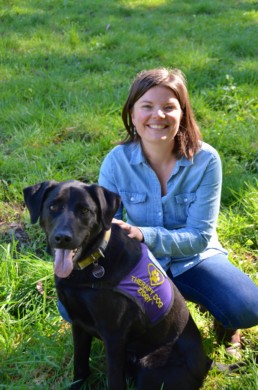
Shanti is a licensed clinical social worker and is an expert in animal-assisted therapy. In addition to having a blast, the kids are learning new skills while they get to know Ziggy and each other—skills like healthy boundaries setting, effective communication, teamwork, and leadership.
Kids in Integrity Housing are having adventures at sleep-away camp! One awesome young woman graduated from camper last year to counselor this year—a paying job that allows her to mentor younger kids and help them find their voices and explore their talents and interests.
Our generous donors fund these enrichment programs. Thank you to everyone who’s stepped up!
Upcoming Events at COTS

Please join us for a free picnic at the Mary Isaak Center, Thursday, July 11 to celebrate the expansion of our community meals program.
For years, thanks to your support, we’ve been able to provide three meals a day to our residents and lunch to anyone who is struggling to make ends meet. This month, we were able to expand the program and have opened dinners to the larger as well. Now, we’re able to to reach people who are working or studying during the day, offering a nutritious evening meal to anyone who’s hungry.
Your support made it possible for us to qualify for the anonymous funding to expand the program. Please join us to celebrate between 5:30 and 7:30 p.m., July 11, at 900 Hopper Street. We’ll have live music from the Rivertown Skifflers and special crafts and activities for kids. Everyone is welcome to Mary’s Table for fried chicken, sides, and a glass of lemonade — with special thanks to Petaluma Poultry and Preferred Sonoma Caterers.
Please RSVP at cots.org or call Jamieson Bunn at 765-6530 x 100.


COTS likely wouldn’t have made it through its first year if it weren’t for the support of our local businesses. A timely donation from Clover, important contributions from Copperfield’s, Petaluma Market, Lace House Linen, and many other companies made all the difference back in 1988. And we never would have made it through the next 29 years if that support had not continued – and grown. We count on local businesses for consistent support but also to respond quickly when government funding priorities change abruptly, or when need becomes particularly acute.
Help us celebrate our generous businesses at a free Chamber of Commerce After Hours from 4:30 to 6:30 p.m., Thursday, July 25, in the Hotel Petaluma Ballroom. Side Dish provides the music, Anna B’s Kitchen provides the snacks, and some of our best local makers provide beer and wine.
The event is also your first opportunity to purchase tickets for the greatest raffle drawing of the year. The Realtors® and support staff at Century 21 Bundesen collaborate with local restaurant owners to provide exquisite dining packages to give away as raffle prizes—all to benefit COTS. Last year’s raffle raised $20,000 to support our programs and services, and this year’s prizes look better than ever. Join us on July 25 for your first chance to win!
To learn more, contact Eileen Morris at 765-6530 x 128.
Finally at home

In May, we shared the story of our client Dennis, who was recently approved for an affordable senior apartment. We are excited to report that Dennis moved into his new apartment on his birthday in June. Here he is enjoying a little cake in his comfy chair after spending the better part of an hour on the phone with PG and E (a classic rite of passage for every new renter!). The same day he moved in to his new apartment he was back to volunteer in the kitchen, serving our residents.
“Dennis left something here with me,” Mary Isaak Center resident Reggie told us today. “He taught me to persevere. I’m not going to get discouraged.”
Thank you to everyone who responded to our request to help Dennis furnish his apartment. Your donations enabled us to provide him with a bed, kitchen utensils, and a place to sit and read after a long day.
Have an item you wish to donate? Visit our website to find out more.
Enduring Commitments
Henrietta Heyman and Betty Louise “Belu” Jones lived lives of service and civic engagement. Both women had long careers in education and social services. Henrietta, who died at age 102, worked in munitions during World War Two. They were both singers, harmonizing through the 60s with Petaluma’s Les Chansonettes. Belu was a sculptor, active in the Petaluma Arts Council. Both Henrietta and Belu found time to support many causes, including COTS and the Petaluma Library.
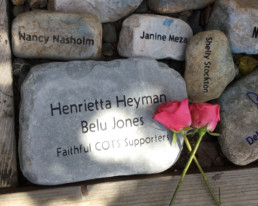

Their support didn’t end after death. Through their wills, these two friends made a huge contribution to ending homelessness in Sonoma County. We are grateful they chose COTS as their instrument. Together with Joe Cochrane from the Petaluma Library, we met recently to place a stone in our memorial garden, honoring Henrietta and Belu.
Our peaceful garden memorializes the clients we’ve lost as well as our important supporters—all are joined together in the garden and in our hearts.
Thank you, Henrietta and Belu.
You can find out more about gifts to COTS that endure here.
Passion Projects
To benefit COTS, sixth-graders Ryan and Anais made and sold one-of-kind art pieces. Fourth-grade “Go Girls,” Taylor and Ava baked and sold cookies, cakes and pies. The staff at Bay Alarm held a yard sale. Blue Door Yoga held a meditation event. Brandon dedicated his birthday. Terra Firma Realty donated a percentage of their fees. The Birdhouses for COTS group decorate and sell miniature bird houses at the east side farmer’s market. Kay DeMartini hosts a story-telling event, “Long Story Short,” the second Friday of every month at Griffo Distillery.
Those are just a few of the fundraisers people have put on for COTS in recent weeks.

We love win-wins around here. You can support COTS while doing things that are fun and social or while you’re learning new skills or sharing your talents. And by sharing your love of COTS with your community, you help us sustain and expand our programs – helping more individuals, families, and children move out of homelessness to a permanent home.
For more information about fundraising for COTS, please visit Become a COTS Fundraiser.
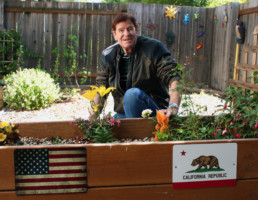
Dennis
You can’t count on kindness paying off, but it’s awfully nice when it does.
Dennis was an old hand at camping by creek sides—unnoticed much of the time—when he met an elderly brother and sister who weren’t as skilled. They had no tent, just sleeping bags and scattered bags of possessions out in the open. Dennis came upon them one day as they were on a pedestrian bridge, feeding ducks. “They were green,” Dennis says. “They didn’t know what they were doing.”
He offered them a place at his campsite and helped them get a tent. The trio looked out for each other and kept each other company. Soon, Dennis extended an invitation to another man and their neighborhood was complete. They kept their camp clean and drug free, Dennis says.
Then the brother and sister met Cecily Kagy, COTS Outreach worker. Within a few weeks, she helped them move into a rental.
Cecily had learned about Dennis from the brother and sister she’d helped. Now it was his turn. “I was on the street for eight years,” Dennis says, “and Cecily was the only person who ever approached me to say, ‘I want to help you.’”
“I was hesitant at first,” he says. “I figured it wasn’t going to go anywhere. I figured I’d probably die on the streets.”
It was a belief that made sense. Dennis had lost his rental housing in Petaluma when he was 57, after a long career installing dry wall. 40 years of repetitive use injuries, a bad case of arthritis and a nonwork-related fall that broke his hip and several other bones left him unable to work for long stretches. He camped, mostly, with short stints in shelters or motels. He worked through a temp agency when he could, but he could never save enough to get ahead. When he turned 62 he was eligible for Social Security, but that didn’t provide him enough to save for move-in costs and rent.
Cecily arrived at an opportune time.
He needed to go to court, where the District Attorney was proposing two years’ probation for a camping ticket. Cecily drove him to the Court House, and during a break in the proceedings, they talked about Dennis’ resources and hopes.
In the next days, they got busy. Dennis met Cecily at a Starbuck’s to fill out a housing application. She helped him prepare for his interview. By the time his next court date rolled around, a room had come open in COTS Integrity Housing program and he’d been approved. “When they heard that I had a place lined up, they dropped the charges,” Dennis says. “If it hadn’t been for Cecily, I’d still be homeless and I’d be on probation.”
Now, days away from his 65th birthday, Dennis shares a home with three others. The rent is a stretch—about half of his monthly income—but adds up to less than what he spent on the four or five hotel stays per month he paid for to shower and clean up.
After he spent one uncomfortable night on a twin bed, Cecily helped find him a queen-sized bed, which is a better fit for his six-foot-seven frame.
“The calm, the relaxed way you feel: that’s the biggest difference. I don’t go to sleep afraid that someone’s going to wake me up yelling, ‘Police. Exit the tent with your hands showing.’ I can walk home from the store and I don’t have to watch my back wondering if someone is going to see where I live and rob me or harass me.”
Free from the grind and all the tasks of camping, Dennis is just getting a feel for how to spend his days. One of the last things he did before he moved in was to talk with the other man at his campground, a veteran who’d resisted meeting Cecily. “He found out I was moving,” Dennis says, “and he said, ‘Tell her I’m interested.’”
Chuck's Virtual Coffee - June 2019
As COTS’ CEO, each month I take a moment to consider what I want our community to know about our organization and our progress in serving Sonoma County’s homeless. I look forward to sharing these thoughts with you in this Virtual Cup of Coffee – my monthly communique about the business and mission moments of COTS (Committee On The Shelterless). In the Business portion, I will share the nuts and bolts of what we do to serve the homeless – our successes and our challenges. In the Mission Moment, I will share stories about our clients and our wonderful staff who make it all happen. I hope you enjoy it, and I look forward to your feedback.
All my best,
Chuck

By the Numbers
I often I get the questions, “What’s your budget size? How many staff do you have? What are the sources of your funding or what percent of funding comes from government?”
This month, we passed our annual operating budget for the new fiscal year beginning July 1. We started this process four months ago as it takes time – meeting with program staff to better understand their programs and impact; determining needs and gaps in services; deciding what’s realistic and not; ensuring that the budget is aligned with our goals and strategic plan; and concluding how much we can put away in savings to then reinvest in COTS for improvement projects down the road.
There are lots of checks and balances to make sure we are responsible stewards of the funds received. Our Finance and Executive Committees and senior management review the budget and ask lots of questions before we take it to the full board of directors for another review and then final approval.
Our budget is $7M, with 37% of that from federal, state, and local government grants, 36% from foundations, donations and monies raised at events like the COTS Hour, and 18% from what we call In-Kind Contributions – the value of all the volunteer time and food/clothing donations made to COTS. The balance is from miscellaneous income. We have 47 employees at COTS. Salaries and Wages make up 47% of the expenses, 12% are for “Pass Through” – monies we received from grants that go towards rental assistance and substance abuse treatment, 16% for In-Kind Contributions as mentioned above, with the balance for all the other expenses needed to run a business.
The budget included funding for a Winter Shelter beginning December 1, 2019 through March 21, 2020. That means on the cold and wet nights, we can get about 35 people off the streets into our warm and safe shelter at COTS and give them a hot meal. We also have a grant to upgrade our shelter that will include some ADA requirements as we are seeing more seniors and more people in wheelchairs and walkers. And thanks to another grant, plus our very generous community, we will offer dinner to those that are hungry with no place to eat.
Thank you for your trust in COTS and for your very generous gifts of time, talent, and treasure that make our work possible.

Living with Dignity
Earlier this month, we had a client pass away at the shelter. Sadly, this is common in shelters and on the streets across the U.S. Studies show that the chronically homeless die on average 20 years earlier than the average citizen. A Bay Area study on homeless deaths showed some 400 deaths on the streets of San Francisco since 2016.
Given a choice, many of us would prefer to die at home amongst family and loved ones. But our clients don’t always have that choice as they may be alone or alienated from their family or friends. Our COTS team work closely with our clients. We get to know them as human beings: their stories, struggles, and their hopes and dreams. Our housing navigators, site coordinators, kitchen staff, and volunteers almost become their family. So when someone dies, we take it very hard. This particular client lived on the streets before coming to MIC, and our staff worked hard to get him into the shelter where he started to eat, get medical attention, and improve his hygiene. As one staff said, “at least he died with dignity and that is what’s important.”
Dying with dignity is important and so is living with dignity. That’s why we make sure our clients are fed healthy, nutritious meals, get case management, and soon, have access to mental health services. While we can’t reverse the hard living and aging process that happens quickly on the streets, we can at least lessen that impact. We can also get clients into a place to live, which is such an effective way to end homelessness and help them begin the healing process.
We can also do one more thing to help our clients live with dignity. And that is to see those experiencing homelessness through the lens of compassion. Certainly more money, housing, and policy changes will help solve this issue. But so will more empathy, understanding, and less fear.
Mary’s Table, the dining room at the Mary Isaak Center, will be open to anyone experiencing hunger for dinner as of July 1, 2019! To celebrate, we’re hosting our first ever FREE all-community picnic. RSVP online by clicking here. We hope to see you there!

Until next month,

Chuck Fernandez



